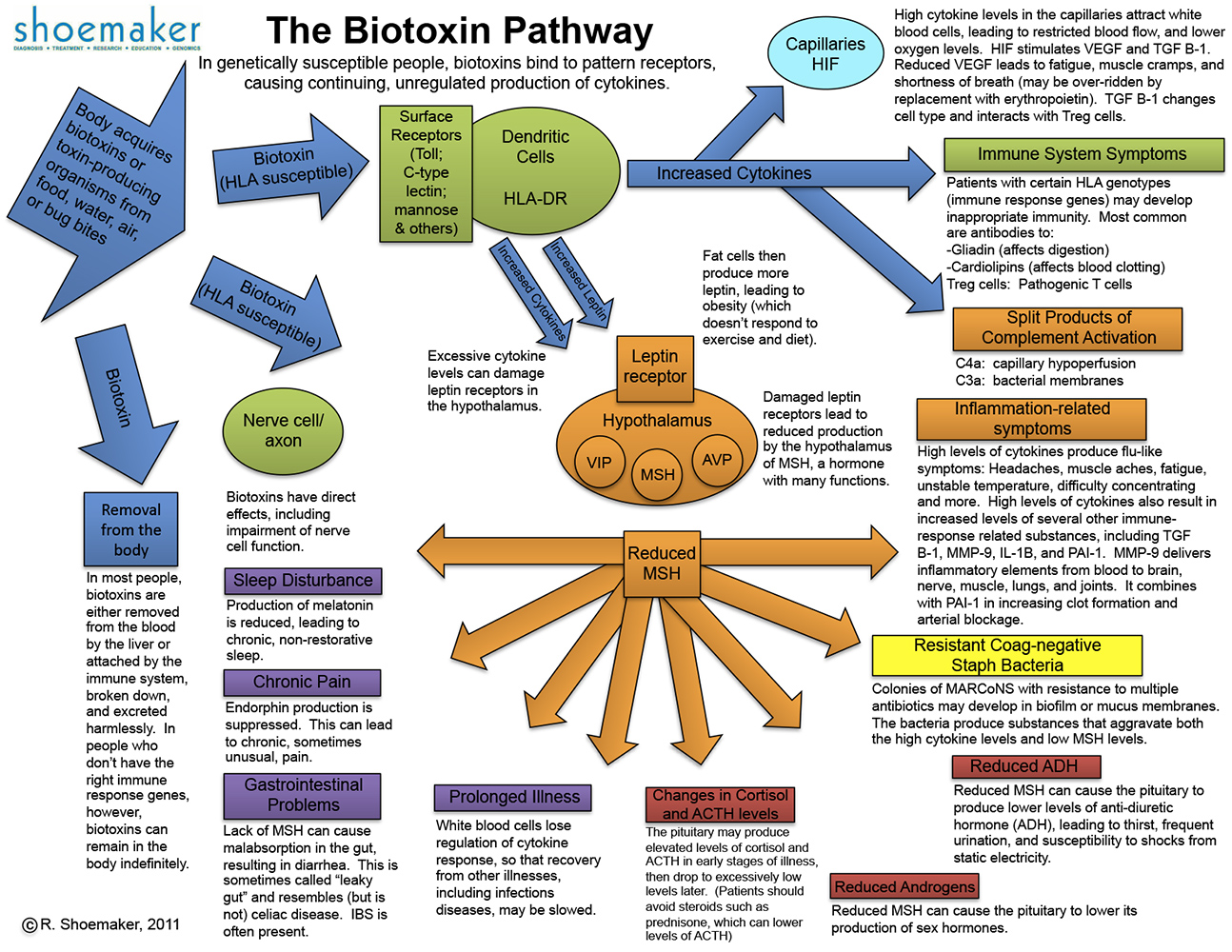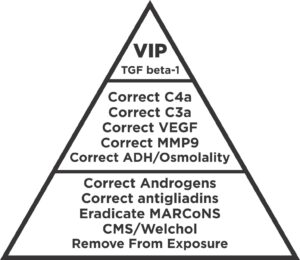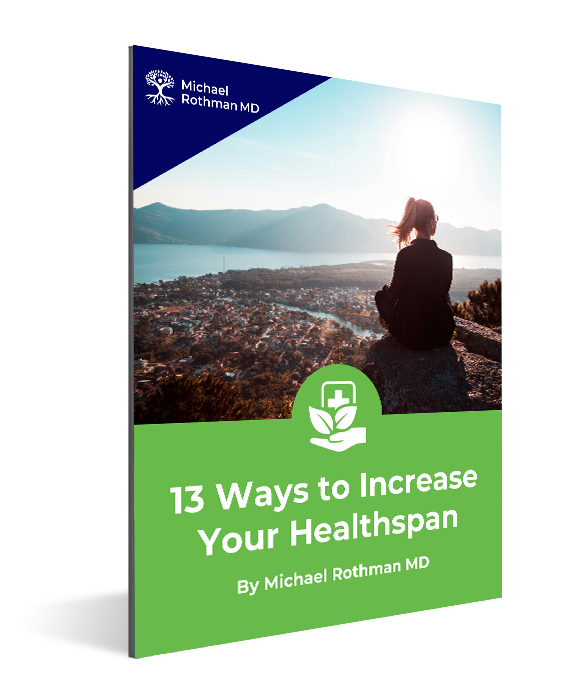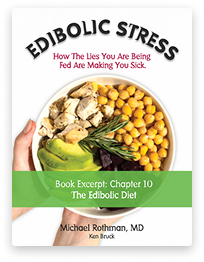Mold Related Illness (CIRS)
Chronic Inflammatory Response Syndrome
(The Surviving Mold Protocol)
The overall goal of the Surviving Mold Protocol is to help you survive mold (and other biological toxins). Surviving mold may be the biggest challenge of your life. Your survival depends on you and your doctor’s ability to understand and adhere to the Surviving Mold Protocol.
The following protocol, based on the work of Dr Ritchie Shoemaker represents a paradigm change in medicine. This brilliant, intuitive, and fearless scientist has opened a completely new world in the treatment of biotoxin (biological toxin) illness. Biotoxins result from your exposure to biologically produced poisons from water-damaged buildings (WDB), which contain fungi, bacteria, actinomycetes, and mycobacteria. WDBs also may be the source of inflammatory producing substances including endotoxins, beta glucans, hemolysins, proteinases, mannans, spirocyclic drimanes, and volatile organic compounds (VOC’s). WDB’s are responsible for the majority of biotoxin illnesses (80%); however, other sources of biotoxins include tick bites (and consequent tick borne illnesses like Lyme’s disease), poisonous blue- green algae, and toxic fish.
Something fishy was happening
Dr Shoemaker was practicing as a Board Certified Family Physician working in the Maryland area in the mid-nineties. At that time, there was an outbreak of unusual and mysterious illnesses in and around the Chesapeake Bay area. Many people were suffering from a variety of symptoms such as nausea, diarrhea, headaches, abdominal pains, chronic fatigue, joint and muscle pains, memory loss, brain fog, red irritated eyes, asthma attacks and skin rashes.
Dr Ritchie Shoemaker treated several of these patients. Among them was a thirty-year-old woman who became ill after swimming in the Pocomoke River. She had terrible headaches, as well as abdominal pains, diarrhea, nausea and a poor appetite. Her diarrhea was becoming more problematic. Dr Shoemaker tested her for a variety of illnesses, and tried treating her with anti-diarrhea medicine and antibiotics, but to no avail. She had been sick for weeks and her diarrhea and other symptoms were not getting any better, when Dr Shoemaker gave her a drug named Cholestyramine (CSM). CSM works by binding your bile salts, but was originally developed to lower your cholesterol These bile salts contain large amounts of cholesterol and when bound to CSM tend to have a constipating effect. As Dr Shoemaker had hoped, the woman’s diarrhea was successfully treated. Surprisingly however, the patient’s chronic fatigue, aches, pains, headaches, and stomach pains all improved within three days of treatment with CSM. Additionally, all of her symptoms completely resolved within two weeks of her treatment with this bile binding drug. Dr Shoemaker started prescribing CSM to other “mystery illness” patients, with similar positive results.
Connecting the dots
Dr Shoemaker came to the realization that the patients he was treating with CSM, must have been sickened by some sort of biological poison since this drug’s only function is to remove bile from your body. Further investigations by Dr Shoemaker and other investigators revealed that these biotoxins were extremely small. Even more insidiously, these tiny toxins can travel almost anywhere in your body because they are both fat and water-soluble.
Dr Shoemaker published his experience with this “mystery disease” in the Maryland Medical Journal November/December 1997 in an article titled; “Diagnosis of Pfiesteria – Human Illness Syndrome”. Pfiesteria is a biotoxin forming dinoflagellate that had killed billions of fish in the bays and rivers of Maryland and North Carolina in the mid 1990’s.
WDBs also cause Biotoxin Illness
Shortly thereafter, Dr Shoemaker started recognizing patients that had symptom clusters similar to his Pfiesteria patients. Upon further investigations, he astutely concluded that the aerosols produced in WDBs could also contribute to biotoxin illnesses. Finally, in September 2003, Dr Shoemaker, Dr Hudnell and Dr House gave a presentation at the fifth International Conference on Bioaerosols linking sick building syndrome to biotoxins produced in WDBs. Over the ensuing years, Dr Shoemaker continued his research and collaborations, adding to his knowledge and understanding of how various biotoxins contribute to a multitude of chronic “incurable” diseases. He eventually developed a scientifically supported model of biotoxin illness that he named The Biotoxin Pathway:

Genetic Link to Mold Related Illness
The Biotoxin Pathway illustrates that if you are genetically predisposed to biotoxin illness (HLA susceptible) your chances of having a mold illness (or other biotoxin illness) goes up enormously. In fact, Dr Shoemaker has found that 95% of his biotoxin illness patients have one or more of these defective genes.
Immunological “blind spot”
The Biotoxin Pathway reveals that if you are genetically susceptible to biotoxins, then your adaptive immune system (antibody producing system) is unable to recognize these biotoxins. Consequently, your will not be able to produce antibodies to these biotoxins. How can you kill that which you cannot detect?
Innate immunity works just fine……..for awhile
Your innate immune system does respond to biotoxin exposure and will unleash an attack on the biotoxins in your body. This primitive and imprecise part of your immune system will attempt to burn up the biotoxins by releasing inflammatory chemicals known as cytokines. Normally your innate and adaptive immune systems work together to eradicate biotoxins. However, since you have an immunological “blind spot”, you never make the antibodies needed to completely destroy the biotoxins. Consequently, your innate (primitive) system keeps producing cytokines, wreaking havoc on your body. Over time, these cytokines produce a chronic inflammatory response syndrome (CIRS), which resembles flu-like symptoms.
You may be thinking to yourself, why did I get sick now
If I have had these genes my whole life, why was I well for so many years, yet I am so sick now? The key concept to explain this phenomenon is gene activation. Your genes coding for these inflammatory responses were relatively dormant for your entire life, but were triggered by some immunologically stressful event. These triggering events could be high levels of mold exposure, a tick bite, a viral illness or a multitude of other stressful circumstances. Once your genes have been activated, you will become much more sensitive with each subsequent exposure to biotoxins.
The importance of your hypothalamus
As you examine Biotoxin pathway, note the central location of your hypothalamus and its influence on a myriad of symptoms. You must understand that your hypothalamus is the control center of every function in your body. When operating properly, this important and powerful part of your brain will direct your nervous system, immune system and endocrine system to create a state known as homeostasis. Homeostasis is the ability to control the internal environment of your body. When you and your hypothalamus are able to maintain a state of homeostasis, you will enjoy vibrant health, free of physical pain and suffering. However, if your hypothalamus and its various inputs and outputs are under sufficient stress for a long enough time, then this vital part of your brain will no longer be able to maintain homeostasis. Consequently, you will suffer clinical manifestations (symptoms) in many of your organs, tissues and cells.
Your hypothalamus normally makes sufficient quantities of two very important regulatory peptides, melanocyte stimulating hormone (MSH) and vasoactive intestinal peptide (VIP). You will lose hypothalamic control if your MSH and VIP levels drop. Your overall state of health will decline as your immune, neurological and endocrine systems become more dysfunctional. Consequently, each successive mold (biotoxin) exposure produces symptoms that are worse then the time before.
Non-linear dose response curve
You must understand that your inappropriate and excessive response to mold exposure is the problem, not the amount of mold (biotoxin). Even a miniscule amount of mold (biotoxin) can cause you to have a severe reaction if you are susceptible.
Differential Diagnosis
My first priority as your doctor is to try to identify if you are indeed suffering from a biotoxin mediated chronic inflammatory response syndrome (CIRS). In other words, “What are the possible different causes of your symptoms and are you indeed “a case” of biotoxin illness (CIRS)?”
Case Definition for CIRS
Symptoms cluster – typical symptoms of CIRS include, unexplained fatigue, brain fog, muscle aches, joint pains, headaches, multiple chemical sensitivities (MCS), rashes, chronic infections, food intolerances, frequent urination, static electric shocks, temperature fluctuations, insomnia, dizziness, memory problems, light sensitivity, asthma-like symptoms (cough and shortness of breath), abdominal pains, nausea, diarrhea and other chronic unexplained symptoms
History of exposure to water damaged buildings (WDB), tick bites, poisoned fish or toxic blue-green algae.
Evidence of genetic predisposition – seen with HLA-DR testing
Evidence of presence of neurotoxins – as demonstrated by visual contrast sensitivity (VCS) testing
The case definition also requires a significant number of the following lab abnormalities:
Evidence of Multiply Antibiotic Resistant Coagulase Negative Staph (MARCoNS) – MARCoNS can be silently growing deep within your sinus cavities (and maybe even in your teeth). A slimy layer called biofilm protects these nasty, drug resistant bugs. MARCoNS secrete substances that can increase inflammation in your body and products that destroy your MSH. A special test kit featuring an API-staph nasal swab must be used and sent to Microbiology DX labs in Massachusetts. If you grow bacteria that are resistant to two or more antibiotics, then you have MARCoNS.
Evidence of gliadin antibodies as seen on blood testing
Evidence of hypothalamic dysfunction as related to hormonal imbalance – high (or low) cortisol, high (or low) adrenocorticotropic hormone (ACTH), high estrogen and low testosterone
Evidence of hypothalamic dysfunction related to water/electrolyte imbalance – low levels of anti-diuretic hormone (ADH) with (or without) simultaneous elevated serum osmolarity. You may suffer from frequent urination, frequent thirst and susceptibility to static electric shocks. The shocks occur because low ADH causes loss of water from your body, leading to high levels of sodium (and chloride) in your blood. Your sweat will be extra salty as your body is trying to excrete this salt and this leads to the susceptibility to static electric shocks.
Evidence of tissue damage (remodeling) – elevated matrix metalloproteinase -9 (MMP-9), elevated transforming growth factor beta-1 (TGF beta-1)
Evidence of anaerobic (lack of oxygen) metabolism – measured by an echocardiogram, revealing evidence of tricuspid regurgitation (backward flow of blood) resulting from pulmonary artery hypertension (PAH). Poor capillary transport of blood into your pulmonary arteries causes PAH because of constricted blood vessels. Your anaerobic metabolism can also be measured with magnetic resonance spectroscopic analysis, which reveals low levels of brain glutamate/glutamine ratios and high levels of brain lactic acid. You may also have low levels of vascular endothelial growth factor (VEGF)
Evidence of elevated cytokine levels – high serum levels of C3a (activated 3rd component of complement) and C4a (activated 4th component of complement)
Evidence of hypothalamic dysfunction related to inadequate levels of regulatory neuropeptides– low levels of melanocyte stimulating hormone (MSH), or vasoactive intestinal peptide (VIP)
Evidence of hypothalamic dysfunction as related to immune imbalance – low CD4+/CD25++ counts
Evidence of brain swelling (edema of brain tissues) in your hippocampus, frontal lobes and your cerebellum secondary to loss of integrity of your blood-brain-barrier, and shrinking of your caudate nuclei secondary to cell death and “dendritic pruning”. These brain abnormalities can be measured using a computer-based analysis of an MRI (magnetic resonance imaging) known as NeuroQuant.
Evidence of other physiologic disturbances like abnormal bleeding (depressed levels of von Willabrands factors), abnormal coagulation (decreased platelet activating inhibitor -1) and other autoantibodies (anticardiolipin, anti myelin basic protein)
Now that you have been identified as a case of CIRS, you must be diligent and careful to do things the right way.
Taking action to Survive Mold – 3 Rules
Rule #1 – Do one thing at a time
Rule #2 – Monitor results with objective biomarkers
Measure labs, VCS, MARCoNS testing, echocardiography, NeuroQuant MRI scans and other physiologic parameters at appropriate intervals to help guide your therapy.
Rule #3 – Improve your health habits
This third rule is not part of the official Surviving Mold Protocol. This rule is from my personal experience helping thousands of patients over the last 3 decades. The more good things (and the less bad things) that you do for yourself, the better you will be able to Survive Mold. You need to make your health a priority. If you do too many bad things to yourself, you will put too much stress on your immune, neurological and endocrine systems. This INE stress will contribute to hypothalamic dysfunction. Bad health habits can really destroy your health and sabotage your recovery. Improve the following habits and increase your chances of Surviving Mold.
- You should not: Consume metabolic poisons like sugar, aspartame, Sucralose, monosodium glutamate (MSG), pesticides and insecticides (used on conventional produce), GMOs, antibiotics, growth hormones, and unnatural diets (used on conventional farm animals), toxic inflammatory oils like soy and canola.
- You should: Eat foods that are as natural, healthy and organic as possible. Use only organic butter, coconut oil or olive oil.
- You should not: Over consume carbohydrates (breads, rice, pastas, starchy vegetables) this will increase your insulin levels. High insulin contributes to every chronic degenerative disease by increasing inflammation in your body. High insulin also changes your androgens (like testosterone and DHEA) into estrogens by stimulating your aromatase enzyme.
- You should: Eat plenty of healthy vegetables, meat, fish, eggs, chicken and cheese – preferably organic.
- You should not: stay up too late at night and/or sleep in a room that is exposed to light
- You should: get to bed early, turn off your lights and TV and sleep in pitch black. You should also spend time outdoors exposed to the healing power of fresh air and sunshine and walking barefoot on the Earth
The 12 Steps of The Surviving Mold Protocol

Step #1 – Remove from Exposure
The single most important factor in your fight to survive mold is AVOIDING mold. If you do not succeed in this step, you will be wasting much time, effort, money and other valuable resources. Your health and quality of life will get worse and worse as you experience one setback after another with ever recurring symptoms that “come out of nowhere”.
You must have your home, work, school and other environments checked for mold and inflammagens from WDBs. Many tests and techniques exist to measure environmental safety. However, one testing method that has been clinically shown to correlate with environmental safety is called ERMI – Environmental Relative Moldiness Index. ERMI measures the DNA within dust that has accumulated in your carpets and floors. Since each fungal species has its own unique DNA, the ERMI test can actually measure the relative number of pathogenic (“bad”) fungus verses the relative number of benign (“not harmful”) fungus.
Clinical studies and experience has shown that how “clean” your environment needs to be depends on a few factors. If your MSH is less than 35 (evidence of hypothalamic dysfunction) and your C4a is less than 20,000 (evidence of cytokine activation), then you will most likely tolerate and environment with an ERMI less than 2. However, if your MSH is less than 35 and you have a C4a greater than 20,000 (evidence of much worse cytokine activation), then you need an ERMI <-1. In other words, the sicker you are, the more dysregulated your hypothalamus, the bigger the “cytokine storm”, the more sensitive you are to subsequent exposures and the cleaner your environment needs to be to be nonreactive (well).
We must also consider Biotoxin exposures other than from WDB. For example, you may be suffering from Borrelia spirochetes (from tick bites), poisoned fish, and exposure to dinoflagellate and toxic blue-green algae infested water.
Your remediation and avoidance plan:
This is such an extremely important and complex subject that goes way beyond the scope of this brief article. Briefly, you must remove (very carefully) all of the inflammagens in your environments. This may include discarding papers, cardboard, rugs, or other objects. You may need to remove walls, ceilings and floors. You must also remediate the reason (moisture) that created the environmental problem in the first place. This may require HVAC professionals, plumbers, and contractors. You must also become very vigilant about walking into any building. Up to 50% of all buildings, have unhealthy environments. Be especially careful in libraries, antique stores, and if you think you see or smell something, get away ASAP. Please find reliable, knowledgeable, compassionate and experienced professionals and mentors to guide you.
As you are achieving your mold avoidance strategy, your health should start to improve. In fact, you may be one of those people that merely need to do the first step of the Surviving Mold Protocol in order to get much better. However, you may need to go to the next step of biotoxin removal by using Cholestyramine or Welchol.
Step #2 – CSM/Welchol
Use a bile resin binder to reduce enterohepatic recirculation of Biotoxins – CSM and Welchol are bile-binding resins, which remove biotoxins because they contain side chains (binding sites) that are positively charged. These life-changing medicines bind the negatively charged biotoxins in your bile. CSM is the most powerful drug to use as it has about five times as many binding sites as does Welchol. However, CSM is often troublesome to use because it can cause you to become very constipated. Welchol is better tolerated but much less effective. The adult dose of CSM is 4 grams four times each day and must be taken either one-hour before eating or two hours after eating. Welchol is 625mg tablets, two tablets, three times each day with food.
You may experience worsening symptoms (intensification reaction) after taking several doses of bile resin binders. Dr Shoemaker recommends high dose fish oil for ten days (starting the binder on day six) to decrease this unpleasant reaction. If you suffer from Lyme disease, intensification symptoms are more common and often more severe and may indicate a need for antibiotic therapy against Lyme before treatment with binders.
Step #3 – Eradicating MARCoNS
Identify and treat multiply antibiotic resistant coagulase negative Staph Aureus MARCoNS – Treat using Bactroban, ethylene diamine tetra-acetic acid (EDTA) and gentamicin (BEG spray). The EDTA helps break down the biofilm and the two antibiotics will be able to eradicate your infection. BEG is dosed two sprays to each nostril three times each day for one month.
Step #4 – Correct antigliadins
You must adhere to dietary interventions – avoiding glutens for at least three months if have antigliadin antibodies. You may react adversely to these foods even if you do not make antibodies, and therefore they should be avoided.
The first four steps of the Surviving Mold Protocol are necessary to remove toxic substances from your system and your diet. You will only improve if you successfully remove toxins, otherwise, the toxins will continue to stress your immune, neuro and endocrine systems. This continued stress would keep you from regaining your homeostatic control.
The subsequent eight steps of the Surviving Mold Protocol help you to re-regulate your immune, nervous and endocrine systems. This re-regulation requires that all of your systems are working together in harmony. Consequently, there is quite a bit of overlap in steps five through twelve. In other words, correcting any one step will also help correct your other seven steps. Importantly, Dr Shoemaker has documented that vasoactive intestinal peptide (VIP) has profound positive effects on your immune, nervous and endocrine systems and therefore improves your homeostatic control.
Step #5 Correct Androgens
Improve production of testosterone and decrease conversion of testosterone into estrogen. You must consume adequate levels of cholesterol and saturated fat and not overeat carbohydrates. You must keep your insulin levels low because insulin enhances the detrimental effects of aromatase enzyme. Aromatase enzymatically converts your testosterone into estrogen. You may also benefit from appropriately administered bio-identical hormone replacement therapy (BHRT)
Step #6 Correct ADH/Osmolarity
Improve your water/electrolyte balance- Use DDAVP (as needed) to help normalize your levels. Take 0.2mg DDAVP every other night. You must have your sodium levels checked after five doses (10 days) of treatment, then again five days later.
Step #7 Correct MMP-9
You must be on a low amylose diet for at least thirty days. Dr Shoemaker also recommends high dose fish oil at this step, 2.4 grams of EPA and 1.8 grams of DHA each day for at least one month.
Step #8 Correct VEGF
Same recommendations as step #7
Step #9 Correct C3a
Persistent elevation of C3a indicates that you may have bacterial membranes (Lyme) activating your immune system. You will need antibiotic therapy if you have Lyme disease. In Addition, Dr Shoemaker recommends high dose statin drugs to lower C3a, Atorvostatin (Lipitor) 80mg or Rosuvastatin 40mg each day. You should take Co-Q-10 before and during any use of statin drugs.
Step #10 Correct C4a
This proinflammatory cytokine may self – correct. VIP can be very helpful. Low dose erythropoietin (EPO) has been shown to lower C4a.
Step #11 TGF beta-1
Elevated levels of this growth factor can cause much tissue damage (remodeling) and cognitive dysfunction (brain fog). This may self-correct; you can also reduce TGF beta-1 by taking Losartan (an angiotensin receptor blocker blood pressure drug) 25mg twice each day.
Step #12 VIP
Vasoactive Intestinal Peptide is a key player in the Surviving Mold Protocol – this hypothalamic neurological peptide confers a multitude of positive effects in properly selected and prepared patients:
- Helps normalize ADH/Osmolarity (electrolyte/water balance) via effects on your ADH levels
- Helps normalize your androgen/estrogen balance via effects on aromatase enzyme
- Helps normalize your cortisol/ACTH balance via effects on hypothalamic function
- Helps normalize your immune system balance as evidenced by CD4+/CD25++ levels /Treg levels
- Helps reduce your inflammatory response as evidenced by decreasing C3a, C4a, MMP-9, TGF beta-1
- Helps to reduce “remodeling” of your tissue (Endothelial-Mesenchymal-Transformation) as evidenced by normalization of TGF beta-1 and reduction of MMP-9
- Helps improve your capillary function as evidenced by reduction in post workout pulmonary artery pressure, increase in your anaerobic threshold, reduction of lactic acid, improvement of your glutamate/glutamine balance as measured in your brain by magnetic resonance spectroscopy
- Helps reduce your pulmonary artery hypertension as measured by echocardiography with assessment of tricuspid regurgitation and pulmonary artery pressure
Appropriate Use of VIP
You must meet the following criteria before using VIP:
- Normal Visual Contrast Sensitivity
- ERMI less than 2 in any environment you are in contact with
- A recent negative MARCoNS test
- Normal serum lipase
Test Dose of VIP
You need to have a blood draw (TGF beta-1 and C4a) just before your first dose of VIP. You will repeat the same two tests 15 minutes after your dose of VIP. Your symptoms will improve and your TGF beta-1 and C4a will be reduced if you are successful. Lack of efficacy symptomatically and worsening of your TGF beta-1 and C4a indicate an unsuccessful test dose.

Subscribe For Expert Insights


